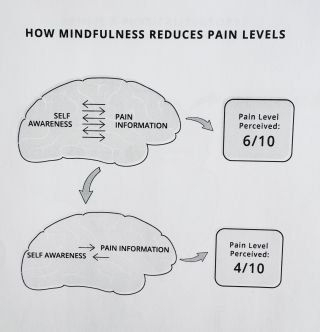Mindfulness
How Mindfulness Practice Reduces Pain
Mindfulness practice reduces perceived pain levels by up to 30 percent.
Posted February 6, 2024 Reviewed by Ray Parker
Key points
- Chronic pain is a physical and emotional experience.
- A negative emotional state increases pain, whereas a positive state lowers pain.
- Mindfulness reduces the connection between the brain areas that process pain and generate self-awareness.
The practice of mindfulness reduces pain levels in a couple of ways. First, it improves awareness of negative emotions and your ability to control them. Two, it reduces the connection between the parts of the brain that process pain and the parts that generate self-awareness. Together, these factors reduce the pain experience.
Negative Emotions Intensify Pain
Chronic pain is a physical and emotional experience. Your emotional state, whether it be sadness, frustration, or happiness, affects how you experience pain. Negative thoughts and emotions increase pain levels.
For example, if you have a headache and are angry about a work conflict, the pain feels worse than if you have the same headache while outside, enjoying the sunshine, feeling content and free.

Emotions affect the experience of pain because the brain processes the physical and emotional aspects of pain together.
- Pain is registered in the brain through multiple inputs.
- One set of inputs reports the location and intensity of the pain (physical experience).
- Another set of inputs connects to the emotional center of the brain, called the limbic system, and reports how unpleasant the pain feels (emotional experience).
- From here, circuits adjust the pain signal, either increasing or decreasing it. Then, the brain lets you know how it feels.
A negative emotional state increases pain, whereas a positive state lowers pain.
The practice of mindfulness improves your awareness and ability to regulate negative thoughts and emotions–such as sadness, anger, or frustration–thereby reducing the pain experience.
Mindfulness Separates “You” From “Pain”
Research shows mindfulness practice reduces perceived pain levels by up to 30 percent.
Mindfulness meditation decreases the communication between the parts of the brain responsible for relaying pain information (thalamus) and the parts that generate self-awareness (default mode network).

There is awareness of self, and there is awareness of pain, but they are not mixed into one. Because they aren’t working as one, the pain level is lower. Think of this pain communication as if the self is not answering pain’s phone calls. The weaker connectivity between the two areas reduces the pain you experience.
Mindfulness fosters a nonreactive sense of self, which includes the experience of pain. The benefits of mindfulness can be gained from a practice of just 20 minutes a day.
Mindfulness Meditation Quick-Start
Here is a simple guide to get started on a mindfulness meditation practice.
- Sit in a comfortable position.
- Focus on your breath, paying attention to breathing in and out. Don’t think or follow any thought streams that pop up. Say “in” as you breathe in and “out” as you breathe out; this blocks intrusive thoughts.
- Start with five minutes a day and work up to 20 minutes a day. Find what works for you.
During meditation, don’t think about anything. If a thought pops up, do not follow it; refocus on your breath. Think of your thoughts as clouds. You are watching them and letting them pass. Focus on blue skies. If the sky fills with clouds, refocus on your breath, refocus on the blue sky.
Learn more about chronic pain management in my book Sunbreak: Healing the Pain No One Can Explain.
References
M. Catherine Bushnell, Marta Ceko, and Lucie A. Low, “Cognitive and Emotional Control of Pain and Its Disruption in Chronic Pain,” Nature Reviews Neuroscience 14, no. 7 (July 2013): 502–11.
Gabriel Riegner et al., “Disentangling Self from Pain: Mindfulness Meditation-induced Pain Relief is Driven by Thalamic-default Mode Network Decoupling.” Pain 164, no. 2 (Feb 2023): 280-291.


